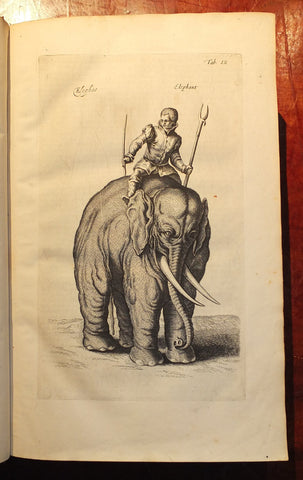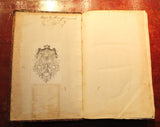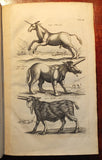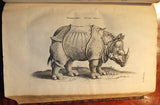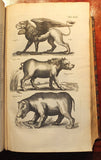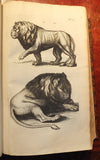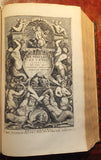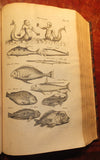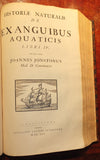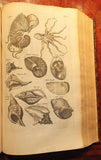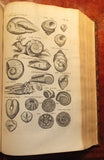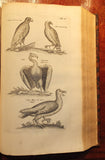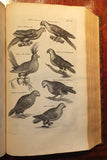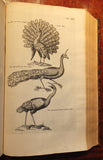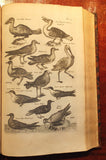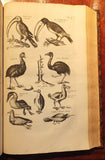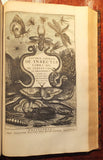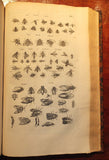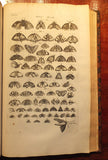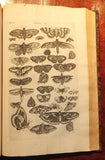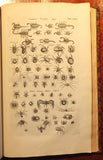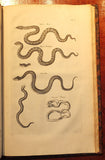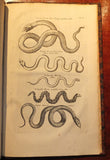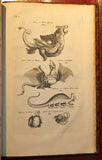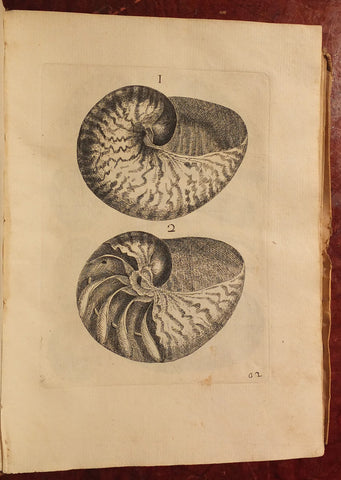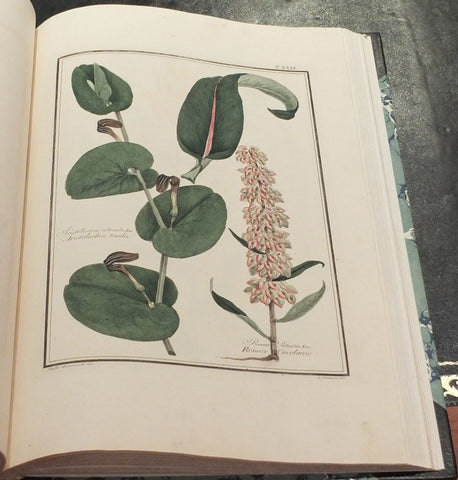John Jonston (1603-1675), Historiae Naturalis de Quadrupedibus...
John Jonston (1603-1675)
Historiae Naturalis de Quadrupedibus...
Amsterdam: Joannem Jacobi Fil. Schipper. 1657.
Folio (14 4/8 x 9 inches). Engraved allegorical title-page, 80 numbered engraved plates of animals after Matthaeus Merian the younger, Caspar Merian, and others (without plates 11 and 12). Contemporary speckled calf, the spine in seven compartments with six raised bands, red morocco lettering-piece in one, the others decorated with fine gilt tools (hinges a bit week, extremities rubbed).
[BOUND WITH]: Historiae Naturalis de Piscibus et Cetis... Amsterdam: Joannem Jacobi Fil. Schipper. 1657. Engraved allegorical title-page, 48 numbered engraved plates of fish and whales after Matthaeus Merian the younger, Caspar Merian, and others
[AND]: Historiae Naturalis de Exanguibus Aquaticis... Amsterdam: Johannis Jacobi Schipperi, 1665. Letterpress title-page with woodcut vignette, 20 numbered engraved plates of sea creatures after Matthaeus Merian the younger, Caspar Merian, and others
[AND]: Historiae Naturalis de Avibus... Amsterdam: Joannem Jacobi Fil. Schipper. 1657. Engraved allegorical title-page, 62 numbered engraved plates of birds after Aldrovandi (1522-1605).
[AND]: Historiae Naturalis de Insectis... Amsterdam: Joannem Jacobi Fil. Schipper. 1657. Engraved allegorical title-page, 28 engraved plates of insects
[AND]: Historiae Naturalis de Serpentibus... Amsterdam: Joannem Jacobi Fil. Schipper. 1665. Letterpress title-page with woodcut vignette, 12 numbered engraved plates of snakes and serpents
Provenance: from the large and distinguished library of the dukes of Arenberg, with their engraved armorial bookplate (by E. Vermorcken according to A. F. Schoy) with their motto "Christus meus protector", annotated by hand; with the ownership inscription of Joseph Van Huerne, from Bruges, celebrated collector and patron whose famous cabinet of curiosities was dispersed at his death in 1844.
Second edition of the first four titles and first edition of the last two. The first four were first issued in Frankfurt between 1650-1657, when this famous compendium of the animal kingdom was considered the standard zoological encyclopedia of its era, combining works on quadrupeds, birds, insects, aquatic life, and reptiles, bound here in one large volume containing 250 folio-sized plates, most of them with several figures each. Finely engraved, carefully detailed, and often featuring a touch of whimsy, these are among the most pleasing zoological plates produced in the 17th century. Mythical animals such as the griffin, the phoenix, and a variety of unicorns are pictured alongside real creatures, some of which no doubt seemed equally improbable to 17th-century Europeans.
Matthäus Merian and his heirs published the first titles in Jonston's series in Frankfurt from 1650 to 1652. They were reprinted in 1657 by Schipper, as here, expanding the scope to include Shellfish and Snakes in 1665.
Though born and educated first in Poland, Jonston's family were of Scottish descent, and "in 1622 [he went] to the University of St Andrews. Here he matriculated as Polonus Patre Scoto Prognatus on 29 January 1624, and studied Hebrew, divinity, and philosophy until March 1625. Jonston spent the next four years abroad but returned to England towards the close of 1629, taking courses in botany and medicine at Cambridge, and continuing his studies in London during 1630, when he wrote the greater part of his first important work, the 'Thaumatographia'. He next proceeded to study medicine at Leiden, where he graduated MD in 1632. In a visit later that year to England he was admitted to the same degree ad eundem at Cambridge. After more travel on the continent, Jonston appears to have settled in Leiden about 1634. He practised medicine there for several years and gained a great reputation. He wrote in Latin on a number of subjects, and was considered a polymath by a number of his contemporaries... Jonston was offered the chair of medicine at the University of Leiden in 1640, and two years later a similar offer was made by the elector of Brandenburg. Jonston, however, declined these offers, preferring instead to study independently. His works were considered by some to be laborious compilations, while Chaufepié and other critics suggested they exhibited more learning than judgement. However, in England his efforts were much esteemed during the seventeenth century. His chief works included 'Thaumatographia naturalis, in decem classes distincta' (1632), which was dedicated to Prince Janusz Radziwill and his son, Boguslas, 'Systema dendrologicum' (1646), 'De piscibus et ceti's' (1649), 'De avibus' (1650), 'De quadrupedibus' (1652), 'De serpentibus et draconibus' (1653), 'Naturæ constantia' (1652), which was translated by J. Rouland (1657), 'Notitia regni vegetabilis …' (1661), 'Notitia regni mineralis' (1661), and 'Dendrographias, sive, Historia naturalis de arboribus et fructibus' (1662) [of which this is the second edition]. He also published a number of works on history, medicine, and ethics" (Thomas Seccombe, rev. Yolanda Foote for DNB).
Matthaus Merian was a notable Swiss engraver born 1593 in Basel. He learned copperplate engraving in Zurich, though he studied later in such cities as Strasbourg, Nancy and Paris. He returned to Basel in 1615, moving to Frankfurt 1616. There he worked for Johann Theodor de Bry, the celebrated publisher whose daughter, Maria Magdelana he married in 1617. In 1620 he and his family moved back to Basel, though they returned to Frankfurt in 1623. Maria took over her father's publishing house upon his death. Anker 235; Nissen ZBI 2131, 2133, 2134, 2132, and 2135; Wood p 409.
We Also Recommend

